Preliminary Results in Testing of a Novel Asymmetric Underactuated Robotic Hand Exoskeleton for Motor Impairment Rehabilitation
Abstract
1. Introduction
2. Materials and Methods
2.1. General Considerations
2.2. Cable Drive Transmission
- Fin/Fout is the ratio of input to output forces,
- µ is the kinetic coefficient of friction between sheath and cable,
- θ is the total wrap angle.
- T(p) represents the tension of the cable at position p,
- μ is the kinetic friction coefficient between sheath and cable,
- θ is the summation of the bent angle of each segment,
- ν (noted as ξ in some works) is the velocity of the cable relative to the sheath,
- dγ is the angle subtended by the arc of length dx,
- R is the radius of the sheath curvature,
- T0 tendon preload,
- L is the total length of the sheath,
- Tout output tension,
- Tin input tension.
3. Results
3.1. Mechanical Concept
3.2. Mechanical Design
3.3. Manufacturing
3.4. Experimental Testing
3.4.1. Exoskeleton Testing without Wearer’s Hand
3.4.2. Exoskeleton Testing with Wearer’s Hand
4. Discussion
5. Conclusions
Author Contributions
Funding
Acknowledgments
Conflicts of Interest
References
- Cortese, M.; Cempini, M.; De Almeida Ribeiro, P.R.; Soekadar, S.R.; Carrozza, M.C.; Vitiello, N. A Mechatronic System for Robot-Mediated Hand Telerehabilitation. IEEE ASME Trans. Mechatron. 2015, 20, 1753–1764. [Google Scholar] [CrossRef]
- Crawford, A.L.; Perez-Gracia, A. Design of a Robotic Hand and Simple EMG Input Controller with a Biologically-Inspired Parallel Actuation System for Prosthetic Applications. In Proceedings of the 1st IEEE International Conference on Applied Bionics and Biomechanics, Venice, Italy, 14–16 October 2010; pp. 1–8. [Google Scholar]
- Nathan, D.E.; Johnson, M.J.; McGuire, J.R. Design and validation of low-cost assistive glove for hand assessment and therapy during activity of daily living-focused robotic stroke therapy. J. Rehabil. Res. Dev. 2009, 46, 587. [Google Scholar] [CrossRef] [PubMed]
- Sandoval, G.O.; Juan, J.V.; Ignacio, H.A.; Otniel, P.R.; Tripicchio, P.; Hernandez-Ramos, M.; Flores Cuautle, A.; Avizzano, C. Design and development of a hand exoskeleton robot for active and passive rehabilitation. Int. J. Adv. Robot. Syst. 2016, 13. [Google Scholar] [CrossRef]
- Durairajah, V.; Gobee, S.; Rauf, W.; Ngie, K.S.; Lim, J.H.A. Design and development of low cost hand exoskeleton for rehabilitation. IFMBE Proc. 2018, 67, 107–110. [Google Scholar] [CrossRef]
- Chiri, T.A.; Giovacchini, F.; Roccella, S.; Vitiello, N.; Catti, E.; Vecchi, F.C. HANDEXOS: Towards a Support Device for Hand Activities and Elepresence; ESA: Paris, France, 2008. [Google Scholar]
- Conti, R.; Saccares, L.; Giovacchini, F.; Crea, S.; Vitiello, N. IUVO: A Spin-Off Company on Wearable Robotics Technologies. In Biosystems and Biorobotics; Springer International Publishing: Berlin, Germany, 2020; Volume 25, pp. 3–7. [Google Scholar]
- Gorgey, A.S. Robotic exoskeletons: The current pros and cons. World J. Orthop. 2018, 9, 112–119. [Google Scholar] [CrossRef]
- Liu, Y.; Ouyang, D.; Liu, Y.; Chen, R. A Novel Approach Based on Time Cluster for Activity Recognition of Daily Living in Smart Homes. Symmetry 2017, 9, 212. [Google Scholar] [CrossRef]
- Spence, P.R.; Westerman, D.; Edwards, C.; Edwards, A. Welcoming Our Robot Overlords: Initial Expectations About Interaction With a Robot. Commun. Res. Rep. 2014, 31, 272–280. [Google Scholar] [CrossRef]
- Gull, M.A.; Bai, S.; Bak, T. A Review on Design of Upper Limb Exoskeletons. Robotics 2020, 9, 16. [Google Scholar] [CrossRef]
- Pons, L.; Papers, S. Inclusive Robotics for a Better Society. In Proceedings of the Selected Papers from INBOTS Conference 2018, Pisa, Italy, 16–18 October 2018; Springer International Publishing: Cham, Switzerland, 2020; Volume 25, ISBN 9783030240738. [Google Scholar]
- Herr, H. Robotics for Human Augmentation Science AAAS. Available online: https://www.sciencemag.org/journals/robotics/human-augmentation (accessed on 2 July 2020).
- Carbone, G.; Rossi, C.; Savino, S. Performance Comparison Between Federica Hand and Larm Hand. Int. J. Adv. Robot. Syst. 2015, 12, 90. [Google Scholar] [CrossRef]
- Antonio Zappatore, G.; Reina Politecnico di Bari, G.; Zappatore, G.A.; Reina, G.; Messina, A. Analysis of a Highly Underactuated Robotic Hand. Artic. Int. J. Mech. Control. 2017, 18, 20. [Google Scholar]
- Held, L.I.J.; Held, L.I.J. Symmetry and asymmetry. In Quirks of Human Anatomy; Cambridge University Press: Cambridge, UK, 2010; pp. 17–32. [Google Scholar]
- Feigin, V.L.; Nichols, E.; Alam, T.; Bannick, M.S.; Beghi, E.; Blake, N.; Culpepper, W.J.; Dorsey, E.R.; Elbaz, A.; Ellenbogen, R.G.; et al. Global, regional, and national burden of neurological disorders, 1990–2016: A systematic analysis for the Global Burden of Disease Study 2016. Lancet Neurol. 2019, 459–480. [Google Scholar] [CrossRef]
- Van Dongen, S. Human Bodily Asymmetry Relates to Behavioral Lateralization and May not Reliably Reflect Developmental Instability. Symmetry 2018, 10, 117. [Google Scholar] [CrossRef]
- Crivellato, E.; Ribatti, D. Body symmetry and asymmetry in early Greek anatomical reasoning. Clin. Anat. 2008, 21, 279–282. [Google Scholar] [CrossRef] [PubMed]
- Gul, J.Z.; Sajid, M.; Rehman, M.M.; Siddiqui, G.U.; Shah, I.; Kim, K.H.; Lee, J.W.; Choi, K.H. 3D printing for soft robotics–a review. Sci. Technol. Adv. Mater. 2018, 19, 243–262. [Google Scholar] [CrossRef]
- Zhou, X.; Majidi, C.; O’Reilly, O.M. Soft hands: An analysis of some gripping mechanisms in soft robot design. Int. J. Solids Struct. 2015, 64, 155–165. [Google Scholar] [CrossRef]
- Marchese, A.D.; Katzschmann, R.K.; Rus, D. A Recipe for Soft Fluidic Elastomer Robots. Soft Robot. 2015, 2, 7–25. [Google Scholar] [CrossRef]
- Rus, D.; Tolley, M.T. Design, fabrication and control of soft robots. Nature 2015, 521, 467–475. [Google Scholar] [CrossRef]
- Jacob Rosen, P.W.F. Wearable Robotics; Elsevier: Amsterdam, The Netherlands, 2020. [Google Scholar]
- Shahid, T.; Gouwanda, D.; Nurzaman, S.G.; Gopalai, A.A. Moving toward Soft Robotics: A Decade Review of the Design of Hand Exoskeletons. Biomimetics 2018, 3, 17. [Google Scholar] [CrossRef]
- Cao, L.; Dolovich, A.T.; Schwab, A.L.; Herder, J.L.; Zhang, W. Toward a Unified Design Approach for Both Compliant Mechanisms and Rigid-Body Mechanisms: Module Optimization. J. Mech. Des. Trans. ASME 2015, 137. [Google Scholar] [CrossRef]
- Zheng, Y.; Cao, L.; Qian, Z.; Chen, A.; Zhang, W. Topology optimization of a fully compliant prosthetic finger: Design and testing. In Proceedings of the IEEE RAS and EMBS International Conference on Biomedical Robotics and Biomechatronics, Singapore, 26–29 June 2016; IEEE Computer Society: Washington, DC, USA, 2016; pp. 1029–1034. [Google Scholar]
- Rose, C.G.; O’Malley, M.K. Hybrid Rigid-Soft Hand Exoskeleton to Assist Functional Dexterity. IEEE Robot. Autom. Lett. 2019, 4, 73–80. [Google Scholar] [CrossRef]
- Li, M.; He, B.; Liang, Z.; Zhao, C.-G.; Chen, J.; Zhuo, Y.; Xu, G.; Xie, J.; Althoefer, K. An Attention-Controlled Hand Exoskeleton for the Rehabilitation of Finger Extension and Flexion Using a Rigid-Soft Combined Mechanism. Front. Neurorobot. 2019, 13, 34. [Google Scholar] [CrossRef] [PubMed]
- Eguren, D.; Cestari, M.; Luu, T.P.; Kilicarslan, A.; Steele, A.; Contreras-Vidal, J.L. Design of a customizable, modular pediatric exoskeleton for rehabilitation and mobility. In Proceedings of the International Conference on Systems, Man and Cybernetics (IEEE), Bari, Italy, 6–9 October 2019; Institute of Electrical and Electronics Engineers Inc.: Piscataway, NJ, USA, 2019; pp. 2411–2416. [Google Scholar]
- Park, A.E.; Fernandez, J.J.; Schmedders, K.; Cohen, M.S. The Fibonacci sequence: Relationship to the human hand. J. Hand Surg. Am. 2003, 28, 157–160. [Google Scholar] [CrossRef] [PubMed]
- Hutchison, A.L.; Hutchison, R.L. Fibonacci, Littler, and the Hand: A Brief Review. Hand 2010, 5, 364–368. [Google Scholar] [CrossRef] [PubMed]
- Flatt, A.E. Fibonacci: His Numbers and Our Hands. Bayl. Univ. Med. Cent. Proc. 1998, 11, 119–122. [Google Scholar] [CrossRef]
- Birouas, F.; Nilgesz, A.; Avram, F.; Mihalca, V.O. A review regarding hand exoskeleton technologies for rehabilitation. Recent Innov. Mechatron. 2018, 5. [Google Scholar] [CrossRef]
- Shields, B.L.; Main, J.A.; Peterson, S.W.; Strauss, A.M. An anthropomorphic hand exoskeleton to prevent astronaut hand fatigue during extravehicular activities. IEEE Trans. Syst. Man Cybern. 1997, 27, 668–673. [Google Scholar] [CrossRef]
- Wege, A.; Kondak, K.; Hommel, G. Mechanical Design and Motion Control of a Hand Exoskeleton for Rehabilitation. Proc. IEEE Int. Conf. Mechatron. Autom. 2005, 1, 155–159. [Google Scholar]
- New Trends in Mechanism and Machine Science; Wenger, P., Flores, P., Eds.; Mechanisms and Machine Science; Springer International Publishing: Cham, Switzerland, 2017; Volume 43, ISBN 978-3-319-44155-9. [Google Scholar]
- Yang, K.; Yang, G.; Chen, S.L.; Wang, Y.; Zhang, C.; Fang, Z.; Zheng, T.; Wang, C. Study on stiffness-oriented cable tension distribution for a symmetrical cable-driven mechanism. Symmetry 2019, 11, 1158. [Google Scholar] [CrossRef]
- Liang, Y.; Du, Z.; Wang, W.; Sun, L. A Novel Position Compensation Scheme for Cable-Pulley Mechanisms Used in Laparoscopic Surgical Robots. Sensors 2017, 17, 2257. [Google Scholar] [CrossRef]
- Goiriena, A.; Retolaza, I.; Cenitagoya, A.; Martinez, F.; Riafio, S.; Landaluze, J. Analysis of bowden cable transmission performance for orthosis applications. In Proceedings of the IEEE 2009 International Conference on Mechatronics (ICM 2009), Malaga, Spain, 26–29 June 2009. [Google Scholar]
- Makoto Kaneko, T.; Yamashita, K.T. Basic considerations on transmission characteristics for tendon drive robots. In Proceedings of the Fifth International Conference of Advacend Robot. Robots Unstructured Environ, Bello Horizonte, Brazil, 2–6 December 1991. [Google Scholar] [CrossRef]
- Schiele, A.; Letier, P.; Van Der Linde, R.Q.V.D.; Helm, F. Bowden Cable Actuator for Force-Feedback Exoskeletons. Comput. Sci. 2006. [Google Scholar] [CrossRef]
- Grosu, S.; Rodriguez-Guerrero, C.; Grosu, V.; Vanderborght, B. Evaluation and Analysis of Push-Pull Cable Actuation System Used for Powered Orthoses. Front. Robot. AI 2018. [Google Scholar] [CrossRef]
- Birouas, F.I.; Tarca, R.C. Development and testing of a mixed feedback control system for robotic hand exoskeleton. In Proceedings of the 2019 15th International Conference on Engineering of Modern Electric Systems (EMES 2019), Oradea, Romania, 13–14 June 2019; Institute of Electrical and Electronics Engineers Inc.: Piscataway, NJ, USA, 2019; pp. 17–20. [Google Scholar]
- Liu, Y.F.; Li, J.; Zhang, Z.M.; Hu, X.H.; Zhang, W.J. Experimental comparison of five friction models on the same test-bed of the micro stick-slip motion system. Mech. Sci. 2015, 6, 15–28. [Google Scholar] [CrossRef]
- Li, J.W.; Chen, X.B.; An, Q.; Tu, S.D.; Zhang, W.J. Friction models incorporating thermal effects in highly precision actuators. Rev. Sci. Instrum. 2009, 80, 045104. [Google Scholar] [CrossRef] [PubMed]
- Veneman, J.F.; Kruidhof, R.; Hekman, E.E.G.; Ekkelenkamp, R.; Van Asseldonk, E.H.F.; Van der Kooij, H. Design and evaluation of the LOPES exoskeleton robot for interactive gait rehabilitation. IEEE Trans. Neural Syst. Rehabil. Eng. 2003, 11, 288–293. [Google Scholar] [CrossRef]
- Kong, K.; Bae, J.; Tomizuka, M. Torque Mode Control of a Cable-Driven Actuating System by Sensor Fusion. J. Dyn. Syst. Meas. Control. 2012, 135. [Google Scholar] [CrossRef]
- Ding, Y.; Galiana, I.; Asbeck, A.; Quinlivan, B. Multi-joint actuation platform for lower extremity soft exosuits. In Proceedings of the International. Conference Robots Automation (2014 IEEE), Cluj Napoca, Romania, 22–24 May 2014. [Google Scholar] [CrossRef]
- Jeong, U.; In, H.; Lee, H.; Cho, K.-J. Investigation on the control strategy of soft wearable robotic hand with slack enabling tendon actuator. In Proceedings of the International Conference Robots Automation (IEEE), Busan, Korea, 13–16 October 2015. [Google Scholar] [CrossRef]
- In, H.; Kang, B.B.; Sin, M.; Cho, K.-J. Exo-Glove: A Wearable Robot for the Hand with a Soft Tendon Routing System. IEEE Robot. Autom. Mag. 2015, 22. [Google Scholar] [CrossRef]
- Jeong, U.; Cho, K.-J. Feedforward Friction Compensation of Bowden-Cable Transmission Via Loop Routing. In Proceedings of the 2015 IEEE/RSJ International Conference on Intelligent Robots and Systems (IROS), Hamburg, Germany, 28 September–2 October 2015. [Google Scholar] [CrossRef]
- Birouas, F.I.I.; Avram, F.; Tarca, R.C.C. Anthropometric measurements for hand rehabilitation robotic devices using video processing. IOP Conf. Ser. Mater. Sci. Eng. 2018, 444, 052028. [Google Scholar] [CrossRef]
- Tedrake, R. Underactuated Robotics: Learning, Planning, and Control. for Efficient and Agile Machines Course Notes for MIT; Massachusetts Institute of Technology: Cambrigde, MA, USA, 2009. [Google Scholar]
- Zhang, F.; Lin, L.; Yang, L.; Fu, Y. Design of an Active and Passive Control System of Hand Exoskeleton for Rehabilitation. Appl. Sci. 2019, 9, 2291. [Google Scholar] [CrossRef]
- Zhang, W.J.; Van Luttervelt, C.A. Toward a resilient manufacturing system. CIRP Ann. Manuf. Technol. 2011, 60, 469–472. [Google Scholar] [CrossRef]
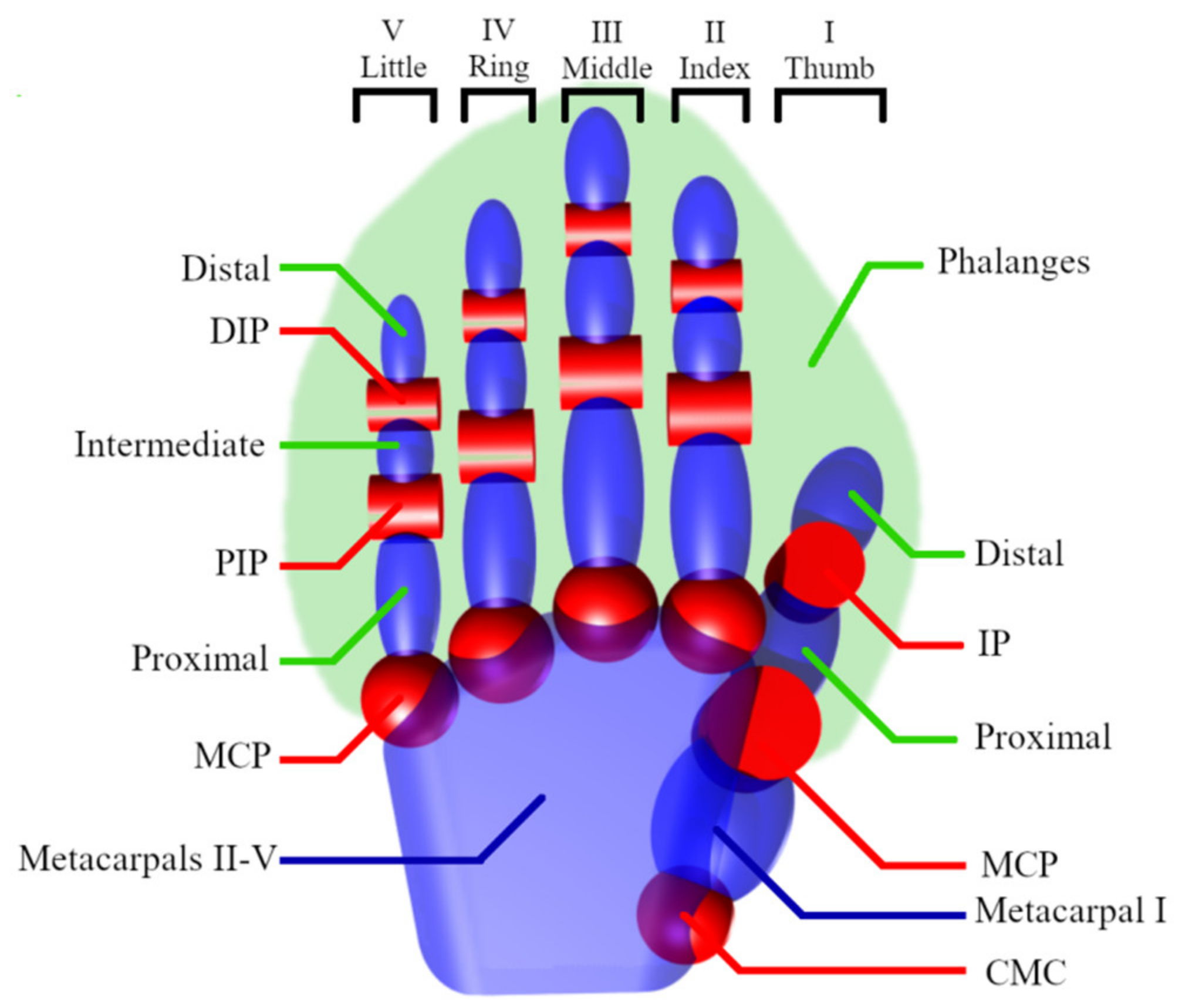

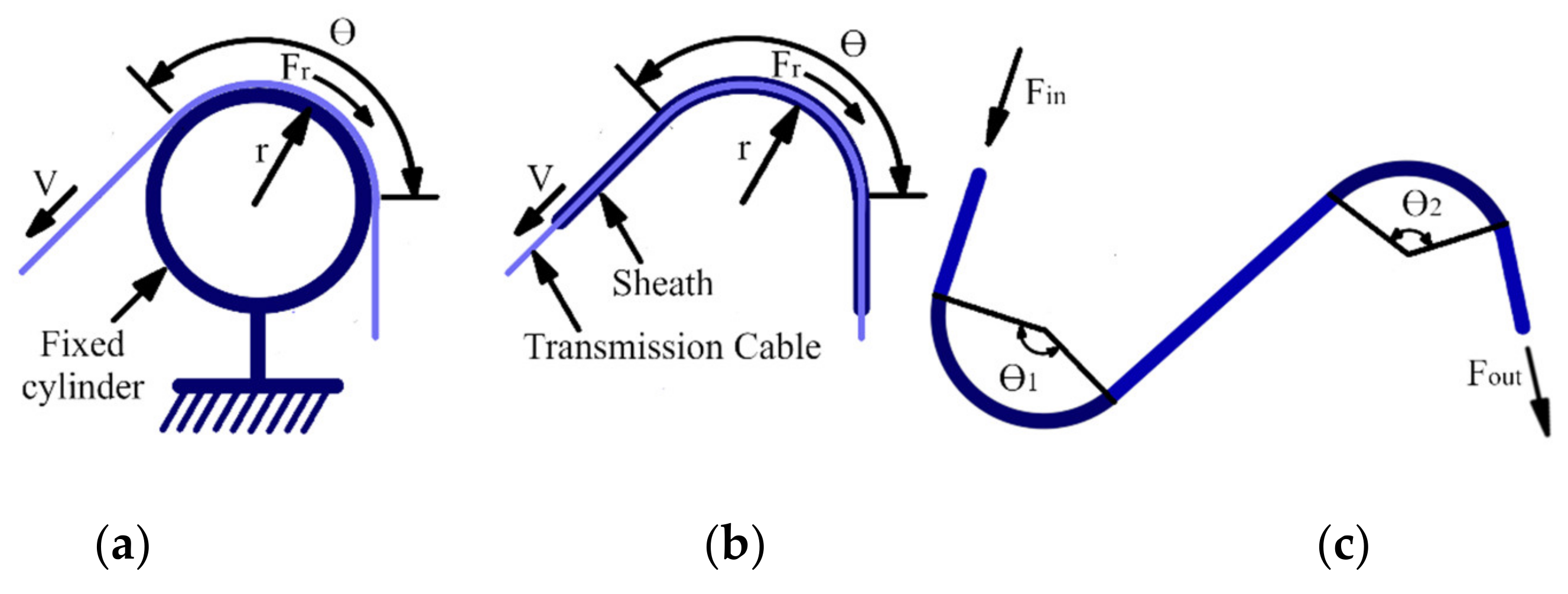
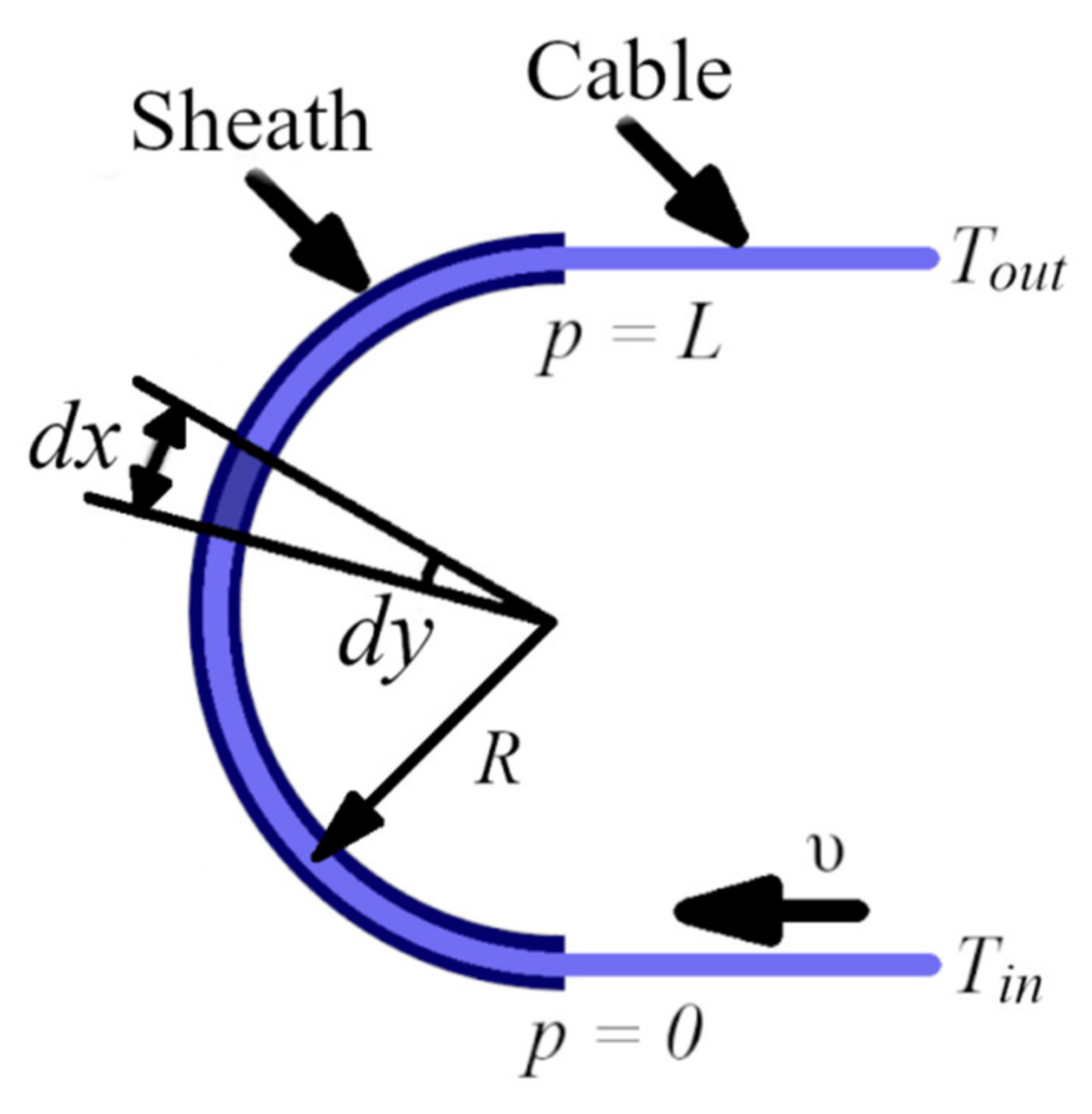

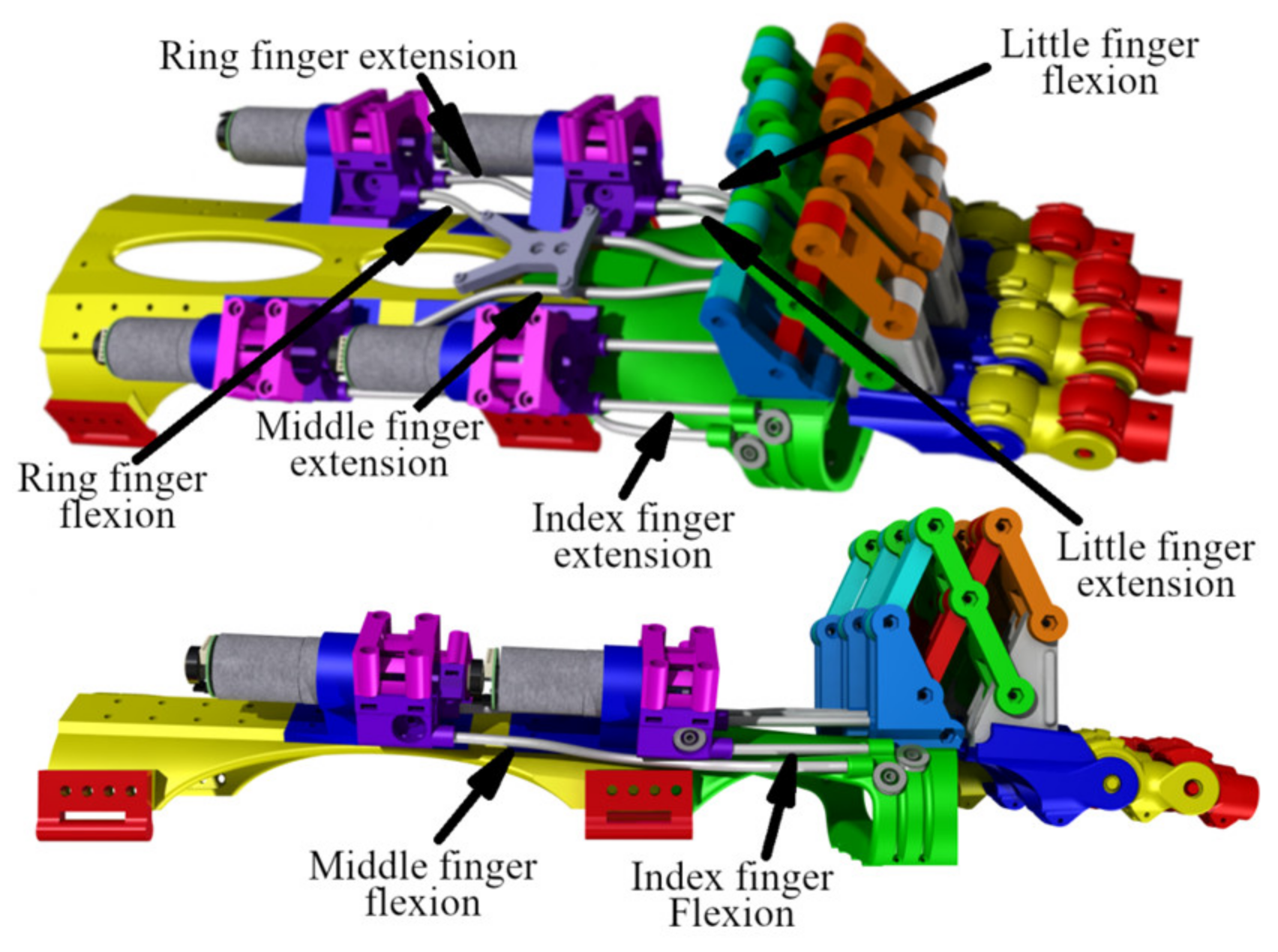
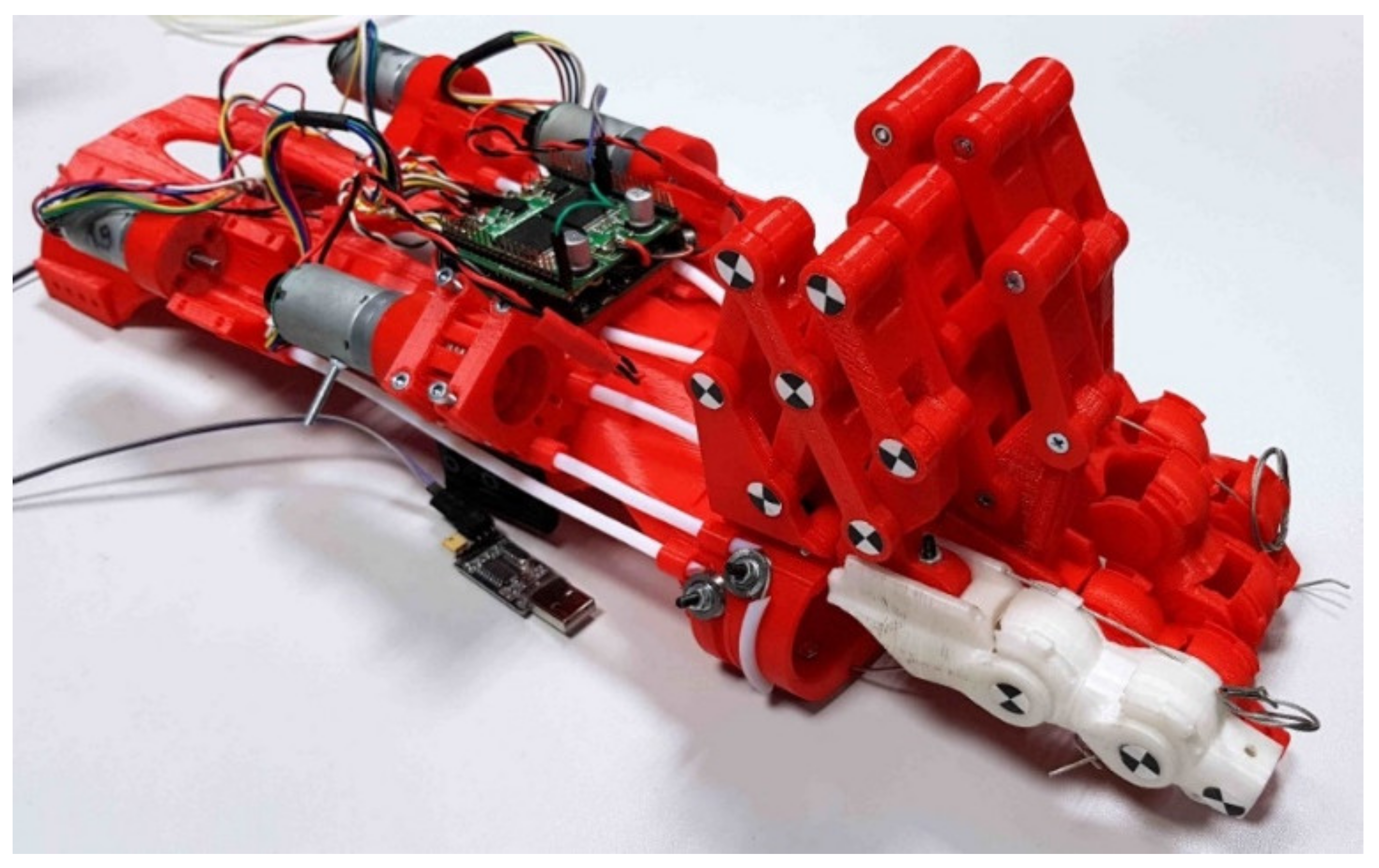
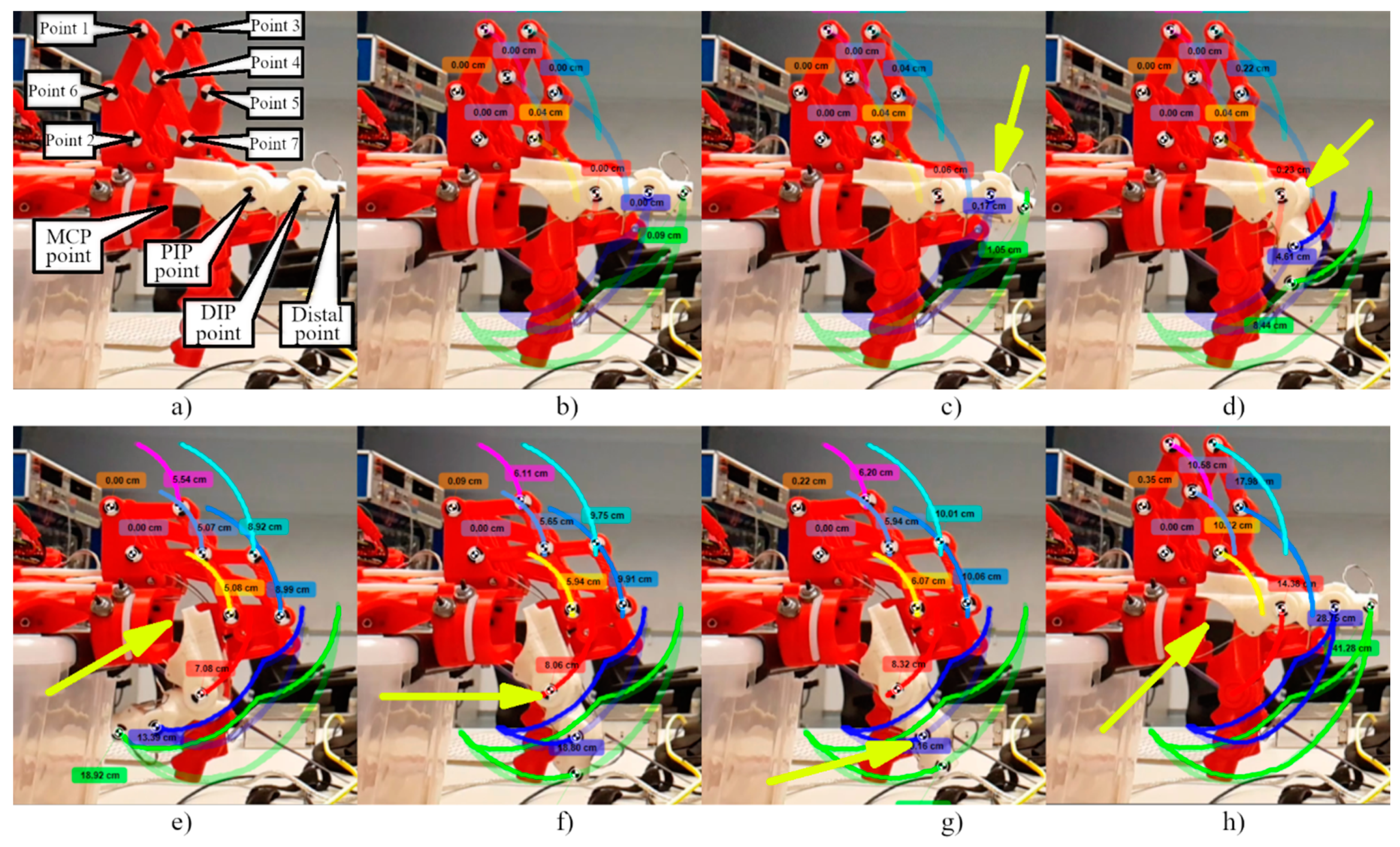
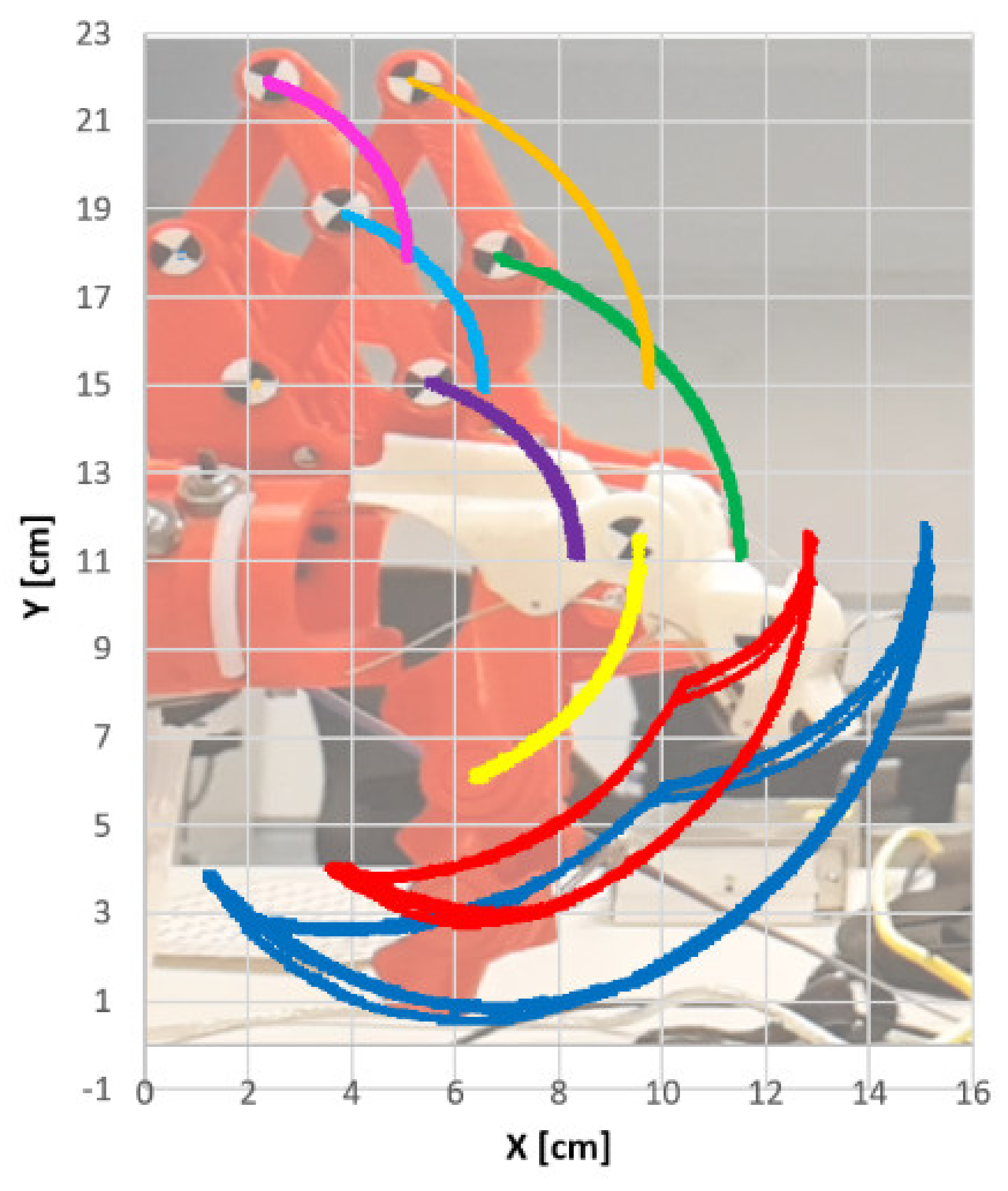
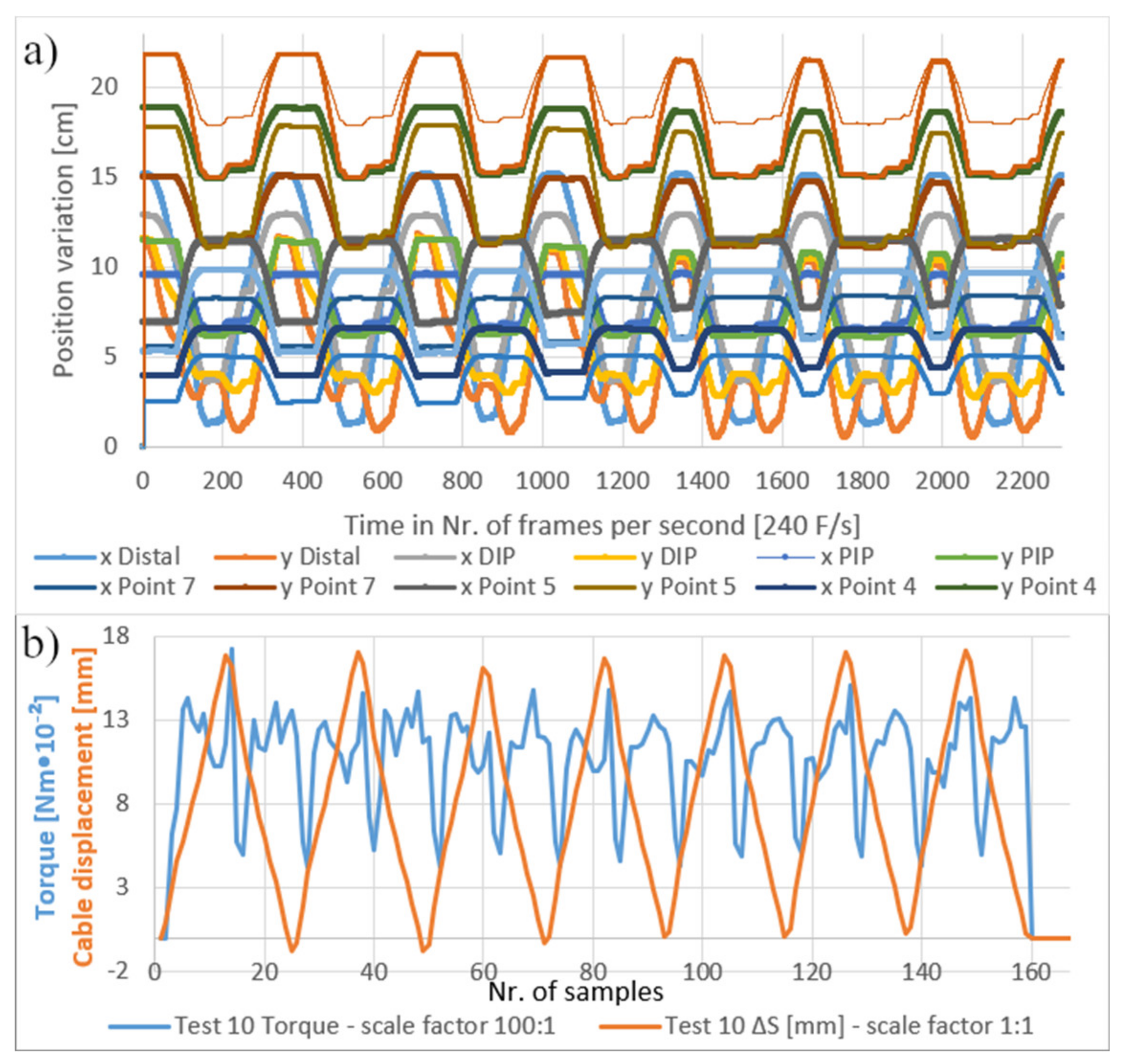


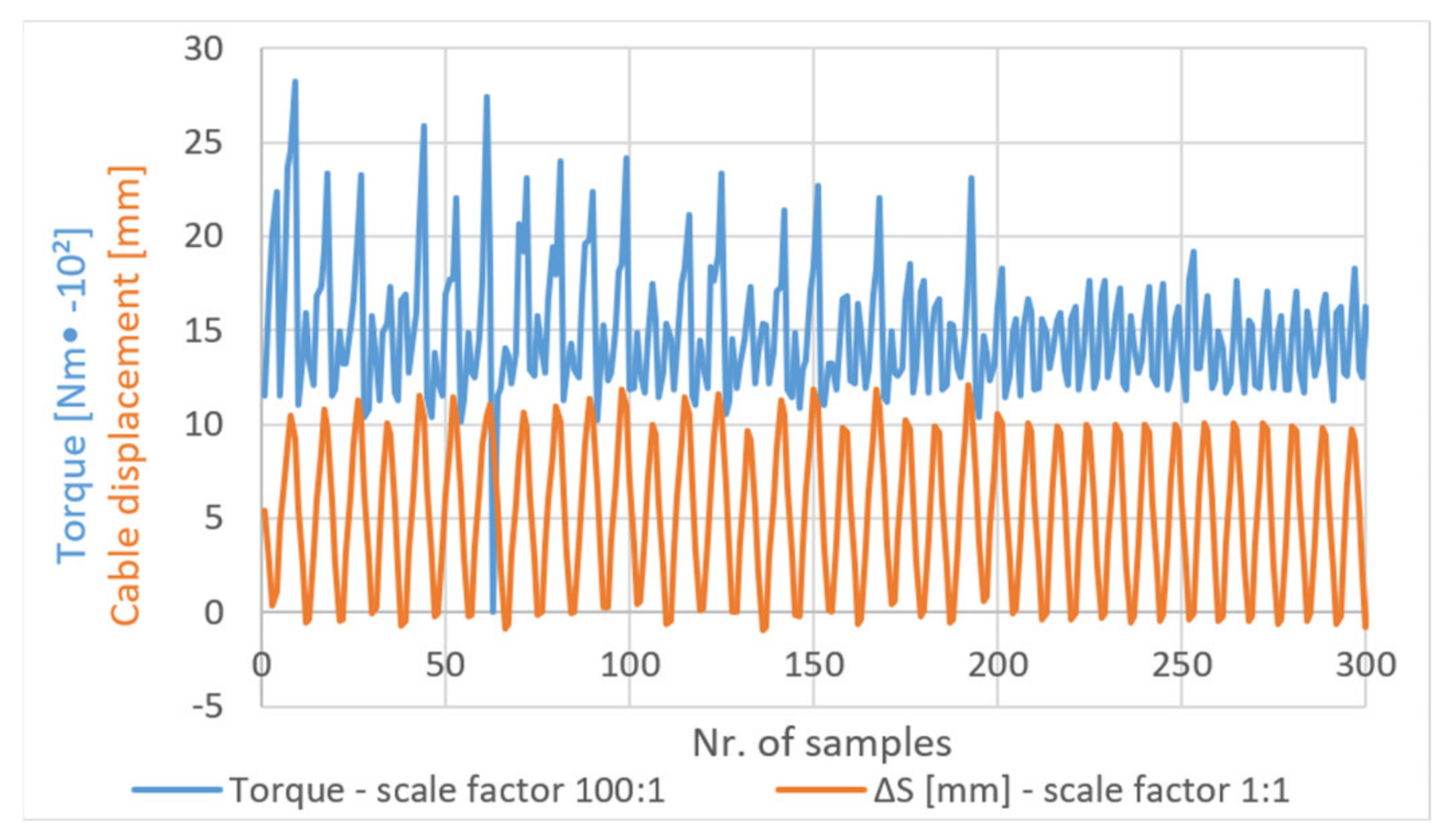
© 2020 by the authors. Licensee MDPI, Basel, Switzerland. This article is an open access article distributed under the terms and conditions of the Creative Commons Attribution (CC BY) license (http://creativecommons.org/licenses/by/4.0/).
Share and Cite
Birouaș, F.I.; Țarcă, R.C.; Dzitac, S.; Dzitac, I. Preliminary Results in Testing of a Novel Asymmetric Underactuated Robotic Hand Exoskeleton for Motor Impairment Rehabilitation. Symmetry 2020, 12, 1470. https://doi.org/10.3390/sym12091470
Birouaș FI, Țarcă RC, Dzitac S, Dzitac I. Preliminary Results in Testing of a Novel Asymmetric Underactuated Robotic Hand Exoskeleton for Motor Impairment Rehabilitation. Symmetry. 2020; 12(9):1470. https://doi.org/10.3390/sym12091470
Chicago/Turabian StyleBirouaș, Flaviu Ionuț, Radu Cătălin Țarcă, Simona Dzitac, and Ioan Dzitac. 2020. "Preliminary Results in Testing of a Novel Asymmetric Underactuated Robotic Hand Exoskeleton for Motor Impairment Rehabilitation" Symmetry 12, no. 9: 1470. https://doi.org/10.3390/sym12091470
APA StyleBirouaș, F. I., Țarcă, R. C., Dzitac, S., & Dzitac, I. (2020). Preliminary Results in Testing of a Novel Asymmetric Underactuated Robotic Hand Exoskeleton for Motor Impairment Rehabilitation. Symmetry, 12(9), 1470. https://doi.org/10.3390/sym12091470






